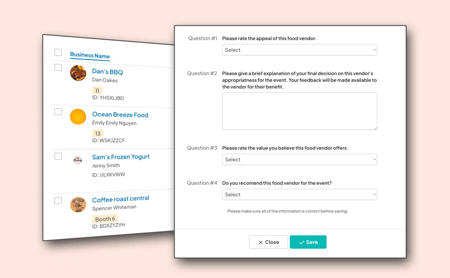Planning an event is exciting—but keeping it safe is essential. Whether you're organizing a street...
Tips for a smooth jury process
Table of Content
- Understanding the jury process
- Why jurying matters for your event
- How to set up an effective jury process
- Step-by-step guide to jurying applications
- Common mistakes and how to avoid them
- Final thoughts
Understanding the jury process
For event organizers, jurying refers to a structured jury selection process for evaluating and choosing the best fit among applicants—such as artists, vendors, or exhibitors—for a particular event. The goal is to ensure your jury pool consists of individuals whose work aligns with your event’s standards and vision. This can be used in a numerous type of ways. For example:
-
Art festivals - rating artwork
-
Food festivals -rating food like pies or burgers
-
Car shows – rating vehicles or custom builds
-
Gaming conventions – rating games or demos
Depending on the type of event, you might draw jurors from service within your organization, invite potential jurors, or even select prospective jurors from the broader community.
Jurying may involve a panel, detailed scoring rubrics, or open-ended jurors questions for more nuanced insights. Methods can range from simple voting to complex rating scales and paragraph feedback.
Why jurying matters for your event
A well-organized jury process is at the heart of any successful event. High-quality and diverse participants contribute to a memorable experience for attendees, while a solid jury selection process upholds fairness and consistency.
Here’s why effective jurying is vital:
- Event organizers can maintain high standards by ensuring only applications that truly fit the event’s goals are accepted.
- Proper selection, often involving a range of potential jurors with relevant expertise, helps foster transparency and impartiality.
- A thoughtful approach lets you handle a large volume of applications smoothly, using clear criteria to guide both the jury pool and the final decisions.
Ultimately, following a systematic jury process—complete with opportunities for jurors to ask questions or flag uncertainties—improves both participant quality and attendee satisfaction.
How to set up an effective jury process
To build a fair and efficient jury application, consider these key steps:
1. Define your criteria
Clarify the standards that will guide your jury pool. Make sure these evaluation points—be it creativity, relevance to the event, professional background, or other factors—are specific and measurable. Share them with prospective jurors, so every member involved in the jury selection process is on the same page.
2. Recruit and prepare your jury team
Select potential jurors and prospective jurors who can bring diverse perspectives and knowledge to the table. If you’re running a larger event, consider drawing jurors from service roles in your broader network. Provide clear instructions on their responsibilities and walk through the review procedure, including how to handle jurors questions or address possible conflicts.
3. Choose scoring methods
- Rating scales: Score applications numerically across different criteria, such as originality or professionalism.
- Yes/no voting: Ideal for quickly screening basic requirements.
- Written feedback: Offers depth and explanation for nuanced cases, much like open jurors questions during actual jury trials.
This combination allows your jury pool to make balanced decisions and gives event organizers comprehensive feedback.
4. Set up an organized platform
Streamline the process, whether using digital forms or an event management software. Ensure your platform is user-friendly so that jurors from service or newly appointed prospective jurors can participate confidently, submit feedback with ease, and track their progress from peremptory challenges to final selections.
Step-by-step guide to jurying applications
- Collect applications: Organize all submissions centrally after your event’s deadline.
- Grant access: Ensure each juror in your jury pool can review the applications relevant to them. If evaluating in rounds, rotate roles or utilize peremptory challenges if a juror needs to be swapped out.
- Evaluate and score: Each juror uses your selected criteria and scoring method. Encourage open communication about jurors questions to prevent misunderstandings.
- Compile results: Aggregate all numeric and written scores for a clear shortlist.
- Discuss and decide: Meet as a team—either in person or virtually—to review top candidates, resolve close calls, or deal with issues raised by potential jurors.
- Notify applicants: Communicate your decisions professionally, offering constructive feedback when possible.
Common mistakes and how to avoid them
- Unclear criteria: Lacking a clear rubric can result in confusion. Provide specific guidelines to both event organizers and everyone in the jury pool.
- Limited communication: Don’t let jurors questions go unanswered. Regular check-ins help everyone stay on track.
- Disorganization: Good record-keeping ensures easy access to all reviews—especially important if you need to refer back for peremptory challenges or select new prospective jurors.
- Bias in selection: Remind all participants to stick rigorously to your criteria, keeping the process as objective as possible, and anonymize applications where feasible.
Final thoughts
A transparent and efficient jury process is essential for event organizers who want to cultivate a successful event, a reliable jury pool, and a fair outcome. With defined criteria, an attentive approach to the jury selection process, and careful attention to the roles of potential jurors and prospective jurors, you’ll build a process that benefits your event and its participants. Whether dealing with jurors from service in your own organization or assembling a new panel drawn from your network, taking the time to get the details right will improve outcomes for all.




